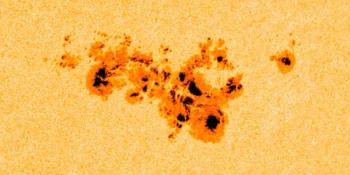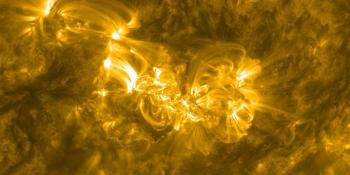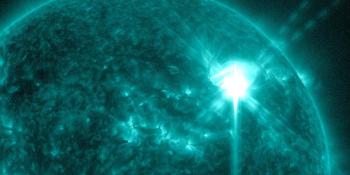Affichage des archives de samedi, 1 septembre 2001
Rapport d'activité solaire
Any mentioned solar flare in this report has a scaling factor applied by the Space Weather Prediction Center (SWPC). Because of the SWPC scaling factor, solar flares are reported as 42% smaller than for the science quality data. The scaling factor has been removed from our archived solar flare data to reflect the true physical units.
Rapport d'activité solaire et géophysique 2001 Sep 01 2200 UTCFait par le NOAA © SWPC et adapté par SpaceWeatherLive.com
Rapport de l'USAF/NOAA sur l'activité solaire et géophysique
SDF numéro 244 publié à 2200Z le 01 Sep 2001IA. Analyse des régions solaires actives et activité du 31-2100Z au 01-2100Z Solar activity was moderate due to a single M-class
event. At 31/2243 UTC, Region 9601 (N14E18) produced an M2.9/2n
flare with an accompanying 540 sfu Tenflare and a Type II radio
sweep (velocity est. 700 km/s). LASCO imagery shows that what
appears to be a non earth-directed CME was also produced by this
flare. Since that event, only sporadic, minor C-class flares were
reported during the period. Region 9601 increased in sunspot count
and developed a delta magnetic configuration late in the period.
Region 9591 (S20W46) continued to show signs of decay, but still
retains a complex beta-gamma-delta magnetic configuration. One new
region was numbered today: 9602 at (S08E30).
IB. Prévisions d'activité solaire
Solar activity is expected to remain
moderate to high. Regions 9591 and 9601 are both capable of
producing M-class events and possibly major flares during the
forecast period. Region 9591 should remain on the visible disk until
04-05 September.
IIA. Résumé de l'activité géophysique du 31-2100Z au 01-2100Z
The geomagnetic field has been quiet to unsettled with an isolated
active period.
IIB. Prévision de l'activité géophysique
The geomagnetic field is
expected to be quiet to active due to recurrent coronal hole effects
as well as possible transient shocks in the solar wind. Isolated
minor storming conditions are possible at higher latitudes.
III. Probabilité d'éruption solaire du 02 Sep au 04 Sep
| Classe M | 80% | 80% | 80% |
| Classe X | 25% | 25% | 25% |
| Proton | 25% | 25% | 25% |
| PCAF | yellow | ||
IV. Flux Penticton 10.7 cm
Observé 01 Sep 184 Prévisionnel 02 Sep-04 Sep 185/180/175 Moyenne des 90 derniers jours 01 Sep 157
V. Indice géomagnetique A
Observé Afr/Ap 31 Aug 011/016 Estimé Afr/Ap 01 Sep 015/015 Prévisionnel Afr/Ap 02 Sep-04 Sep 015/025-015/020-012/015
VI. Probabilités d'activité géomagnétique du 02 Sep au 04 Sep
| A. Latitudes moyennes | |||
|---|---|---|---|
| Actif | 25% | 25% | 20% |
| Tempête mineure | 15% | 15% | 10% |
| Tempête majeure/sévère | 01% | 01% | 01% |
| B. Hautes latitudes | |||
|---|---|---|---|
| Actif | 35% | 30% | 25% |
| Tempête mineure | 20% | 15% | 10% |
| Tempête majeure/sévère | 05% | 01% | 01% |
Dernières nouvelles
Forum
[CME] AR 13664, flare flurry, CMEs galore, 2024-05-08/09 135AR3664 584Is there any truth to this "Internet/Electrical Grid Apocalypse"? 91Weakening of Earths magnetic field due to geomagnetic excursion 19Sporadic E and Flare activity 28
Plus de messages du forumAidez SpaceWeatherLive.com !
Vous êtes de plus en plus nombreux à consulter SpaceWeatherLive pour suivre l'activité solaire ou aurorale, et avec le traffic les coûts du serveur augmentent. Si vous appréciez SpaceWeatherLive, soutenez notre projet en faisant un don afin que nous puissions continuer à vous informer !

La Météo Spatiale en faits
| Dernière classe X | 09/05/2024 | X1.1 |
| Dernière classe M | 10/05/2024 | M1.3 |
| Dernier orage géomagnétique | 06/05/2024 | Kp5 (G1) |
| Jours sans taches solaires | |
|---|---|
| Dernier jour sans taches solaires | 08/06/2022 |
| Nombre mensuel moyen de taches solaires | |
|---|---|
| avril 2024 | 136.5 +31.6 |
| Last 30 days | 167.9 +77.7 |


